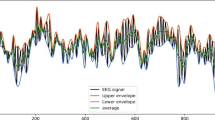Summary
Propofol has been used as IV induction (2 mg/kg) and maintenance agent (150 µg/kg/min and 100 µg/kg/min after 30 min), combined with N2O/O2 in 16 premedicated (atropine 0.5 mg, Thalamonal 2 ml IM) and mechanically ventilated patients, having ear surgery or arthroscopy.
Cranial biopotentials were analysed by 2 different techniques:
-
1.
The Anesthesia and Brain Activity Monitor (ABM Datex) providing the zero crossing frequency (ZXF) as a value for the mean frequency of the EEG signal during a considered time interval, the mean integrated voltage (MIV) as a mean value of the amplitude of the same EEG signal and the spontaneous electromyography of the frontal muscle (SEMG).
-
2.
The EEG trend monitor (rough signal, spectral analysis (S.A.), procentual display).
The EEG changes, recorded during propofol anesthesia, are comparable with both techniques. Induction is characterised by a decrease in ZXF, caused by a procentual increase in the low frequency bands (the delta band represents more than 80% of the total power). During the perfusion period an increase in the power of the alpha band (10% to 40%) and a decrease in the delta band is noticed. The ZXF regains its original value. At the end of the procedure the ZXF increases (beta band to more than 30%).
A correlation was looked for between the EEG changes and the propofol blood concentrations. The higher the propofol blood concentrations, the more pronounced the low frequency bands. The appearance of beta waves or a ZXF greater than 10 Hz indicates pending arrousal.
Similar content being viewed by others
References
Eger EI II. Nitrous oxide N2O. Elsevier: New York, Amsterdam, Oxford, 1985.
Grantham CD, Hameroff SR. Monitoring anesthetic depth. In: Monitoring in anaesthesia and critical care medecine. Churchill Livingstone, pp 435–6, 1985.
Herregods L, Rolly G, Versichelen L, Rosseel MT. Propofol combined with nitrous oxide-oxygen for induction and maintenance of anesthesia. Anesthesia 1987; 42: 360–6.
Kay B. The anaesthesia and brain monitor (ABM) concept and performance. Acta Anaesth Belg 1984; 35: suppl 167–74.
Levy WJ, Shapiro HM, Maruchack G, Meathe E. Automatic EEG processing for intraoperative monitoring: a comparison of techniques. Anesthesiology 1980; 53: 223–6.
Pichelmayer I, Lips U, Künkel H. The electroencefalogram in anesthesia. Fundamentals practical applications, examples. Springer Verlag: Berlin, Heidelberg, New York, Tokyo, 1984.
Rampil IJ. Elements of EEG signal processing. Int J clin Monit Comp 4: 85–98, 1987.
Author information
Authors and Affiliations
Rights and permissions
About this article
Cite this article
Herregods, L., Rolly, G., Mortier, E. et al. EEG and SEMG monitoring during induction and maintenance of anesthesia with propofol. J Clin Monit Comput 6, 67–73 (1989). https://doi.org/10.1007/BF01720415
Issue Date:
DOI: https://doi.org/10.1007/BF01720415




